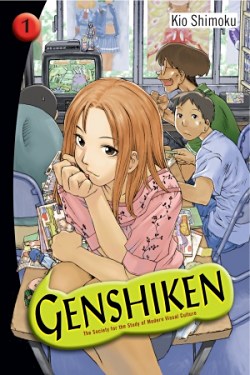February 15, 2007
Cheese! (part 2)
 The kind of stories found in Cheese! (and for that matter, the typical Harlequin romance) highlight the curious differences shounen (boy's) and shoujo (girl's) manga and anime, especially in the ways they treat intimate relationships and the social implications of sex.
The kind of stories found in Cheese! (and for that matter, the typical Harlequin romance) highlight the curious differences shounen (boy's) and shoujo (girl's) manga and anime, especially in the ways they treat intimate relationships and the social implications of sex.This is unrelated to any differences in explicitness. Like shoujo, when called for—to the extent that such things are ever "called for"—shounen manga and anime do not lack for gratuitous nudity and sexual innuendo. It's so ubiquitous that it's referred to by the derisive moniker, "fan service." But the irony about all this sexuality is how rarely actual physical relationships inject themselves into the narrative engines of shounen plots, other than as come-ons to the male id.
Or rather, how often the mere prospect of sex sends the id scurrying. It's a bait and switch gambit.
Even in fan-service fests like Ikki Tousen and Tenjho Tenge, where all of the secondary characters are sleeping around (exception noted below), the leads restrain themselves. In classic Friday the 13th fashion, promiscuity becomes a shorthand indication of moral decrepitude. Consider the ridiculous Girl's Bravo, where the town lecher Fukuyama makes all the sleazy moves while Yukinari plays the perfect gentleman, even when a voluptuous, naked babe materializes in his bathtub.
Three notable exceptions stand out: Bob and Chiaki in Tenjho Tenge, Saki and Makoto in Genshiken, and Seiji and Midori in Midori Days. In the first, Bob is a sidekick and Chiaki a secondary character. More importantly, the Bob and Chiaki relationship is presented as an established fact at the beginning of the series. Still, although tangential to the main storyline, it's the only interesting—and certainly the only mature—boy/girl relationship in the entire show.
In Genshiken, Saki is a "normal" girl who's fallen for Makoto, a hardcore member of Genshiken, the university anime and video game club. They're sharing a bed almost from the start (which is unusual enough), and are more or less making the relationship work, though encountering some expected obstacles in the process, as in a scene where Saki wonders aloud whether the sex life of a certain "hypothetical" couple is dictated by the broadcast schedule of a popular anime series.
There is a serious question whether Genshiken—which also makes it clear (though not cruelly) that the other club members lack significant others pretty because of their obsessive personalities—belongs in the shounen genre. Comic Party, for example, covers similar territory but follows every shounen story element to the letter, including the can't-get-to-first-base relationship between the leads.
Otherwise, shounen writers often resort to plot devices straight out of fantasy horror (of all things!) to keep the boy glued to the girl's side.
In Video Girl Ai, Ai pulls a reverse Poltergeist and oozes out of Youta's television screen. In Midori Days, Seiji wakes up one morning to find that a girl has replaced his right hand (flashback to Bruce Campbell replacing his severed hand with a chainsaw in Army of Darkness). The mad scientist in B-Shock forces Arata and Hatsune together with a kind of deadly proximity device, echoing a similar plot entwining Picard and Crusher in an episode of Star Trek: TNG.
 Strangely enough—or not, when you think about it—these premises actually deliver a more mature level of plot and character development. Midori Days in particular. When "Mad Dog" Seiji finds that his right hand has been replaced by a doll-sized girl, a rather obvious crude joke springs to mind. But it doesn't go there. Instead, it addresses the practical issues of actually living together—in the literal sense of the word—forcing a guy accustomed to favoring brawn over brain to finally grow up and take responsibility for his actions.
Strangely enough—or not, when you think about it—these premises actually deliver a more mature level of plot and character development. Midori Days in particular. When "Mad Dog" Seiji finds that his right hand has been replaced by a doll-sized girl, a rather obvious crude joke springs to mind. But it doesn't go there. Instead, it addresses the practical issues of actually living together—in the literal sense of the word—forcing a guy accustomed to favoring brawn over brain to finally grow up and take responsibility for his actions.However, with the goal of comparing fruits of a similar species, I'm more specifically interested in shounen titles that like their shoujo counterparts depict long-term, committed, and more or less voluntary male/female relationships, where the leads ostensibly want to get together and stay together. While sex may seem to be used to competing ends in the shounen and shoujo genres, I would argue that the same underlying theory is at play in both.
And that is: sex equals big-time commitment.
Consider the opposite: the stock, noncommittal "player" in Hollywood sitcoms. The current television season (and a single network!) alone supplies us with Charlie Sheen in Two and a Half Men, Daniel Patrick Harris in How I Met Your Mother, and David Spade in Rules of Engagement. But unlike the borrish Fukuyama in Girl's Bravo or the gangbangers in Ikki Tousen, they're all lovable scoundrels.
There's a lot more where they came from, not to mention the interminable on-again, off-again ditherings between Ross and Rachel on Friends that lasted the entire run of the show. On the other hand, the Chandler and Monica marriage hardly starved the series for material, and a more inspired handling of the Anya and Xander debacle on Buffy likewise would have injected much needed life into the series, badly flagging at that point.
But in these cases we're specifically talking about marriage. Hollywood is reflecting more than a grain of truth about the male psyche. What is unique about shounen manga is the extent to which sexual intimacy (and not even necessarily consummation) by itself is used as a proxy for commitment and marriage, following exactly the same formulation as that used by shoujo and Harlequin authors.
This makes the Hollywood man the odd man out. Though at the other end of the spectrum, it also makes the restrained shounen protagonist as utterly unreal as the tall, dark, handsome, rougish Harlequin leading man who sweeps a woman off her feet and abruptly settles down with her in marital bliss without breaking his stride.
Take two quintessential shounen relationship series as cases in point: Ah My Goddess and Ai Yori Yoshi. In both, men (they're in college, after all) are in long-term, committed relationships with bright, gorgeous women who adore them. And yet. Only subterfuge or stupidity ever lands them in a compromising position of any sort.
Far from providing fodder for ongoing plots, the eternally-stalled romantic relationship between the leads becomes tedious. Their characters are similarly frozen in amber. The best episode in the 2005 anime remake of Ah My Goddess has Urd (Belldandy's older, randier sister) being turned back into a schoolgirl for a day and initiating a relationship that progresses further in 24 minutes than anything Belldandy and Keiichi had done to date—without Urd twisting arms, that is.
The subtext about sex in shounen manga seemly plainly to be: look but don't touch; imagine but don't act.
You could even call it "chivalrous," albeit in a weirdly objectifying manner. But perhaps herein is revealed the substance of the paradox that Japanese cabinet ministers need to specifically address, rather than describing women as "baby-making machines" who aren't meeting their production quotas.
Welfare minister Hakuo Yanagisawa was responsible for that last indelicate quote. Deflecting calls for Yanagisawa's resignation, Prime Minister Abe valiantly vowed to deal with the declining birthrate by creating
a Japan where people feel at ease to get married and raise their children under a basic strategy of assisting children and families.
Strangely enough, shounen manga and anime are not necessarily antagonistic to "family values." When push comes to shove, it seems that what too many shounen protagonists really want is a sibling, not a spouse. The brave new frontier in Japanese popular entertainment may well be a non-hentai shounen genre in which the romantic leads shack up, get married, life goes on and the world doesn't end in an apocalyptic fireball.
Though if that's exactly the prospect that so frightens teenage boys in the first place, it's doubtful they'd ever accord it the requisite devotion to inculcate the message.
Related posts
Cheese! (part 1)
Cheese! (part 3)
Labels: buffy, cheese, manga, personal favs, sex
Comments
